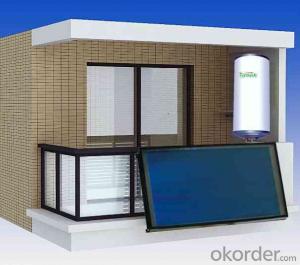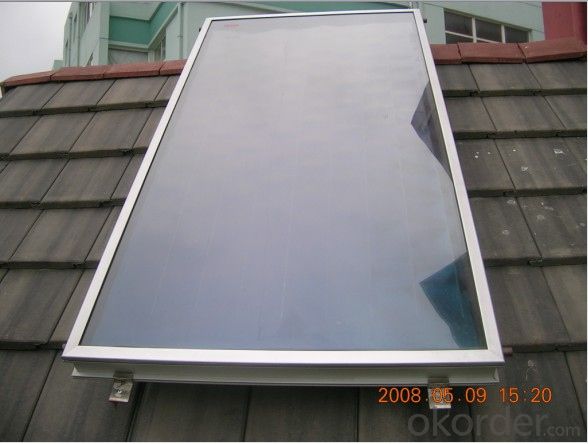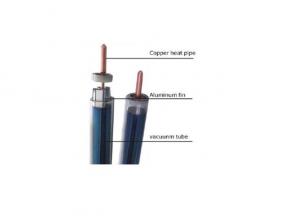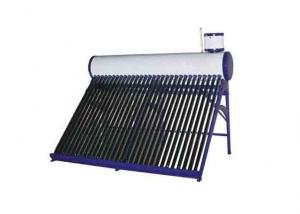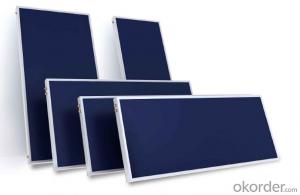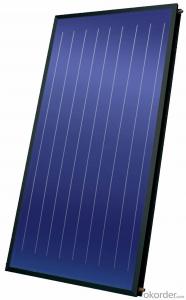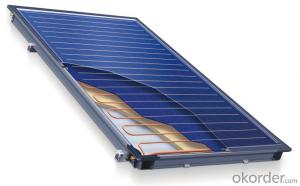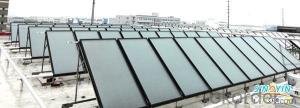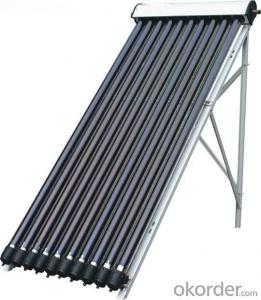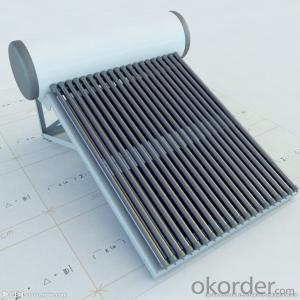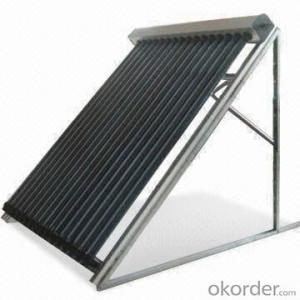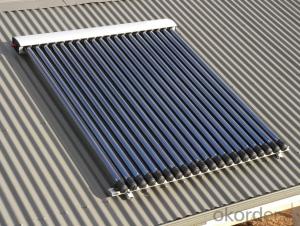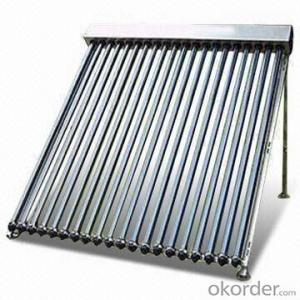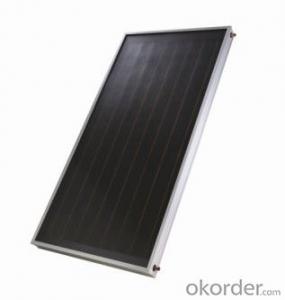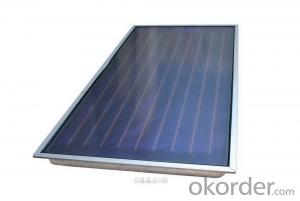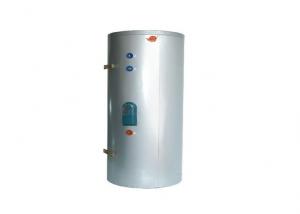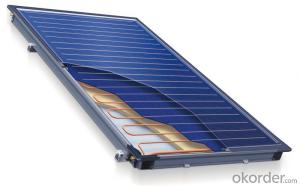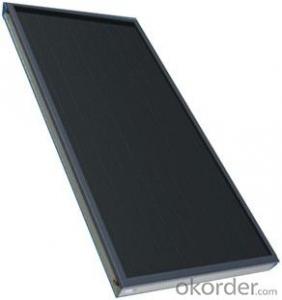Nobel Solar Collectors - Heat Pipe Vacuum Tubes Solar Thermal Collector with Most Reasonable Price
- Loading Port:
- Shanghai
- Payment Terms:
- TT OR LC
- Min Order Qty:
- 500 pc
- Supply Capability:
- 10000 pc/month
OKorder Service Pledge
OKorder Financial Service
You Might Also Like
Heat Pipe Vacuum Tubes Solar thermal collector with most reasonable price China manufacturer : The heat pipe series of solar collectors are always connected with existing heating supply device. The selective coating on the inner glass of the evacuated tube converts solar energy into heat energy and transfers heat to the heat pipes by aluminium fins. The liquid in the heat pipe changes into vapour and rises to the condensation end .The heat passes through the heat exchanger into the inner wall of the vacuum tube and then transfers through the copper pipes into the liquid..The transference of heat into the liquid creaters a continuous circulation as long as the collector is heated by the sun.
FEATURE:
1. Workable at water pressure up to 0.6Mpa.
2.Possible to be connected with existing energy source.
3. Water tank may not be installed together the collector.
4.The pipeline is made of copper and conducted by heat transfer medium liquid. The vacuum tube does not take water.The coating is high strength stainless steel with air flow design ,which is furnished in good style.
5.Possible to withstand high pressure in working condition.
6.Module design, free combination to meet the demand of large water consumption.
Feature:
1,header pipe materia
2,manifold material:aluminum alloy
3,tube dimensions:l1500/47mm or 1800/58
4,vacuum tube coating material:AL-N/AL or AL/N-SS-Cu
5,insulation layer:compressed rock wool
6,test pressure:9bar
7,working pressure:6bar
8,collector mounting:flat roof/inclined roof
9,angle of operation:5 degree-90degrees
10,heat preservation:72 hours
11,hail resistance:25mm
12,copper heat pipes for rapid heat transfer
Primary competitive advantages:
1 ISO,CE,SOLARKEYMARK
2 reasonable price and good quality
3 prompt delivery
4 environmental protection
5 OEM order is available
6 experience of export to 70 countries
7 international quality warranty:10 years for solar cillector and 15 years for vacuum tube
8 runner :copper runner 35mm, 40mm, 42mm
- Q: Are solar collectors affected by hail or other severe weather conditions?
- Yes, solar collectors can be affected by hail or other severe weather conditions. Hailstorms can cause damage to the surface of solar panels, leading to cracks or breakages. Similarly, severe weather conditions like strong winds or heavy snowfall can also impact the efficiency and performance of solar collectors. It is important to consider the durability and protective measures in place when installing solar panels in areas prone to severe weather.
- Q: Can solar collectors be used for generating electricity on smartphones?
- No, solar collectors cannot be directly used for generating electricity on smartphones. Solar collectors are typically used to convert sunlight into thermal energy, which can be used for heating water or air. However, there are solar panels available that can generate electricity from sunlight, and these can be used to charge smartphones and other electronic devices. These solar panels are designed to be portable and can be connected to smartphones via USB ports or other charging cables. They are particularly useful for outdoor activities or in areas where access to electricity is limited.
- Q: Can solar collectors be used in geothermal power generation?
- No, solar collectors cannot be directly used in geothermal power generation as they harness different sources of renewable energy. Solar collectors capture sunlight to generate electricity or heat water, while geothermal power generation utilizes the Earth's heat from deep within to produce electricity or heat.
- Q: Can solar collectors be used for heating in areas with high humidity?
- Solar collectors can indeed be utilized for heating purposes in regions with high humidity. Although the efficiency of solar collectors can be affected to some extent by high humidity, it does not render them completely ineffective. The functionality of solar collectors relies on the capture and conversion of the sun's energy into heat, which can then be employed for heating spaces or water. In areas with high humidity, the presence of moisture in the air can diminish the amount of direct sunlight that reaches the solar collectors. Consequently, this can lead to a slight reduction in efficiency compared to areas with lower humidity. However, even in environments with high humidity, solar collectors can still generate sufficient heat for heating purposes. Additionally, advancements in solar collector technology have resulted in the creation of more efficient and effective systems that are better equipped to handle humid conditions. For instance, certain solar collectors incorporate special coatings on their surfaces to minimize the impact of humidity on their performance. Furthermore, the utilization of heat exchangers and insulation in solar heating systems can further enhance their efficiency in areas with high humidity. It is crucial to note that while solar collectors can still be utilized for heating in regions with high humidity, it is imperative to appropriately design and size the system to account for the unique environmental conditions. This may entail selecting the suitable type of solar collector, optimizing its orientation and tilt, and considering factors such as shading and ventilation to maximize performance. Overall, although high humidity can slightly affect the efficiency of solar collectors, they can still be effectively employed for heating purposes in such areas with careful design considerations and technological advancements.
- Q: Can solar collectors be used for heating research facilities?
- Yes, solar collectors can be used for heating research facilities. Solar collectors harness the energy from the sun and convert it into heat, which can then be used to provide warmth for various purposes including heating research facilities. This sustainable and renewable energy source can effectively contribute to reducing carbon emissions and lowering energy costs for research facilities.
- Q: How do solar collectors perform in dusty environments?
- Solar collectors generally do not perform optimally in dusty environments. Dust accumulation on the surface of solar collectors can reduce their efficiency by blocking sunlight and reducing the amount of energy they can capture. Regular cleaning and maintenance are crucial to ensure optimum performance in dusty environments.
- Q: Can solar collectors be used in fuel cell power plants?
- Solar collectors, like solar panels or solar thermal systems, have the capability to be employed in fuel cell power plants. These collectors enable the extraction of energy from the sun and its conversion into electricity or heat. Within a fuel cell power plant, solar collectors can be utilized to generate the necessary electricity for the electrolysis process, which is accountable for the division of water into hydrogen and oxygen. Subsequently, the produced hydrogen can serve as a fuel for fuel cells, which generate electricity via a chemical reaction between hydrogen and oxygen. Through the utilization of solar collectors, fuel cell power plants can effectively harness a renewable energy source to produce hydrogen, thereby enhancing the overall sustainability and environmental friendliness of the process.
- Q: What is the lifespan of the absorber coating in a solar collector?
- The lifespan of the absorber coating in a solar collector can vary depending on several factors such as the quality of the coating, the type of collector, and the maintenance practices. However, on average, a well-maintained absorber coating can last anywhere between 10 to 20 years.
- Q: Can solar collectors be used for heating ski resorts?
- Yes, solar collectors can be used for heating ski resorts. Solar thermal systems can be installed to capture and convert sunlight into heat energy, which can then be used to warm the buildings and facilities at ski resorts. This renewable energy source can help reduce the reliance on fossil fuels and contribute to a more sustainable and eco-friendly heating solution for ski resorts. However, the effectiveness of solar collectors may vary depending on the location and climate conditions of the ski resort.
- Q: Can solar collectors be used for commercial or industrial purposes?
- Yes, solar collectors can be used for commercial or industrial purposes. They can be employed to generate electricity or heat water for a wide range of commercial and industrial applications, such as powering machinery, heating large buildings, or providing hot water for industrial processes. Solar collectors offer a sustainable and cost-effective solution for meeting energy needs in commercial and industrial sectors.
Send your message to us
Nobel Solar Collectors - Heat Pipe Vacuum Tubes Solar Thermal Collector with Most Reasonable Price
- Loading Port:
- Shanghai
- Payment Terms:
- TT OR LC
- Min Order Qty:
- 500 pc
- Supply Capability:
- 10000 pc/month
OKorder Service Pledge
OKorder Financial Service
Similar products
Hot products
Hot Searches
Related keywords
